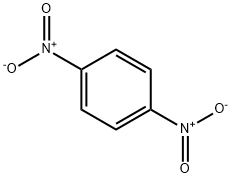파라-디니트로 벤젠
|
|
파라-디니트로 벤젠 속성
- 녹는점
- 170-173 °C(lit.)
- 끓는 점
- 183.4 °C34 mm Hg(lit.)
- 밀도
- 1.625 g/mL at 25 °C(lit.)
- 증기압
- 2.25 x 10-4 mmHg at 35 °C (Hine et al., 1963)
- 굴절률
- 1.725 (589.3 nm)
- 인화점
- 150 °C
- 저장 조건
- Store below +30°C.
- 용해도
- 알코올: 300ml에 1g이 녹습니다.
- 물리적 상태
- 결정 또는 분말
- 색상
- 황토색에서 오렌지색으로
- 수용성
- 물에 용해됩니다. (0.8g/L), 20°C에서.
- Merck
- 14,3273
- BRN
- 1105828
- Henry's Law Constant
- 4.79(x 10-7 atm?m3/mol) at 35 °C (approximate - calculated from water solubility and vapor pressure)
- 노출 한도
- NIOSH REL: TWA 1, IDLH 50; OSHA PEL: TWA 1 ACGIH TLV: TWA 0.15 ppm for all isomers (adopted).
- 안정성
- 안정적이지만 충격에 민감할 수 있습니다. 가열하면 폭발할 수 있음. 산화제, 강염기, 질산, 많은 금속, 산화주석과 호환되지 않습니다.
- CAS 데이터베이스
- 100-25-4(CAS DataBase Reference)
안전
- 위험 및 안전 성명
- 위험 및 사전주의 사항 (GHS)
| 위험품 표기 | T+,N,T,F | ||
|---|---|---|---|
| 위험 카페고리 넘버 | 26/27/28-33-34-50/53-52/53-39/23/24/25-23/24/25-11 | ||
| 안전지침서 | 28-36/37-45-60-61-16 | ||
| 유엔번호(UN No.) | UN 3443 6.1/PG 2 | ||
| WGK 독일 | 3 | ||
| RTECS 번호 | CZ7525000 | ||
| TSCA | Yes | ||
| 위험 등급 | 6.1 | ||
| 포장분류 | II | ||
| HS 번호 | 29042090 | ||
| 유해 물질 데이터 | 100-25-4(Hazardous Substances Data) | ||
| 독성 | IC50 (24-h) for river bacteria 1.27 mg/L (Yuan and Lang, 1997). | ||
| 기존화학 물질 | KE-11935 |
파라-디니트로 벤젠 C화학적 특성, 용도, 생산
화학적 성질
light yellow powder물리적 성질
Clear, colorless to white crystalline solid or monoclinic crystals. Slowly turns yellow on exposure to air.용도
1,4-Dinitrobenzene is used in a study to evaluate the ionization mechanism and solvent effect by novel atmospheric pressure photoionization mass spectrometry in negative ion mode for analysis of some compounds. 1,4-Dinitrobenzene can be used in synthesis of dyes and dye intermediates.정의
ChEBI: A dinitrobenzene carrying nitro groups at positions 1 and 4.일반 설명
Colorless to yellow solid. Sinks and mixes slowly with water.공기와 물의 반응
Slowly mixes with water.반응 프로필
All three isomers have similar properties and may react vigorously with oxidizing materials. Their reaction with nitric acid (nitration) will lead to a mixture of trinitrobenzenes possessing high-explosive properties [Urbanski, 1967, vol. 3, p. 290]. If heat and reaction conditions of the nitration are not controlled, detonation comparable to TNT may occur [Anon., J. R. Inst. Chem., 1960, 84, p. 451]. Mixture of 1,3-dinitrobenzene with tetranitromethane was found highly explosive [Urbanski, 1964, vol. 1, 592]. 1,2-dinitrobenzene is a severe explosion hazard when shocked or exposed to heat or flame. When heated to decomposition all dinitrobenzens emit toxic fumes of nitrogen oxides [Sax, 9th ed., 1996, p. 1374].건강위험
INHALATION OR INGESTION: Headache, vertigo, nausea, vomiting, diarrhea, fever, rapid weak pulse, decreased blood pressure, cyanosis, exhaustion, hepatomegaly, jaundice, albuminurea, hematuria, visual scotomata, amblyopia and nystagmus. EYES: Irritation. SKIN: Stains skin yellow; if skin contact is prolonged, can be absorbed into blood causing same symptoms as for inhalation.Safety Profile
Suspected carcinogen. Poison by ingestion. Mutation data reported. Mxture with nitric acid is a high explosive. When heated to decomposition it emits toxic fumes of NOx. See also 0and mDINITROBENZENE환경귀착
Biological. In activated sludge inoculum, following a 20-d adaptation period, no biodegradation was observed (Pitter, 1976).Photolytic. Low et al. (1991) reported that the nitro-containing compounds (e.g., 2,4- dinitrophenol) undergo degradation by UV light in the presence of titanium dioxide yielding ammonium, carbonate, and nitrate ions. By analogy, 1,4-dinitrobenzene should degrade forming identical ions.
Chemical/Physical. Releases toxic nitrogen oxides when heated to decomposition (Sax and Lewis, 1987). 1,4-Dinitrobenzene will not hydrolyze in water (Kollig, 1993).
Purification Methods
Crystallise 1,4-dinitrobenzene from EtOH or EtOAc. Dry it under vacuum over P2O5. It can be sublimed in a vacuum. [Beilstein 5 IV 741.]파라-디니트로 벤젠 준비 용품 및 원자재
원자재
준비 용품
파라-디니트로 벤젠 관련 검색:
디니트로 벤젠 디니트로 벤젠 M-디니트로벤젠 1-클로로-3,4-디니트로벤젠 파라-디니트로 벤젠 2,5-디메틸톨루엔 1-클로로-2.4-디니트로벤젠 2-브로모-4,6-디나이트로아닐린
9,10-DINITROANTHRACENE
1,2,4,5-tetrachloro-3,6-dinitrobenzene
2,3,4,6-Tetranitroaniline
2,5-DINITROBENZOIC ACID
2,3,6-TRINITROPHENOL
2,4,5-TRINITROTOLUENE
DINITRODURENE
3,5-dichloro-1,2-dinitrobenzene
1,3-Difluoro-4,6-Dinitrobenzene/1,5-Difluoro-2,4-Dinitrobenzene
4-Chloro-3,5-dinitrobenzene sulfonic acid pottasium salt









